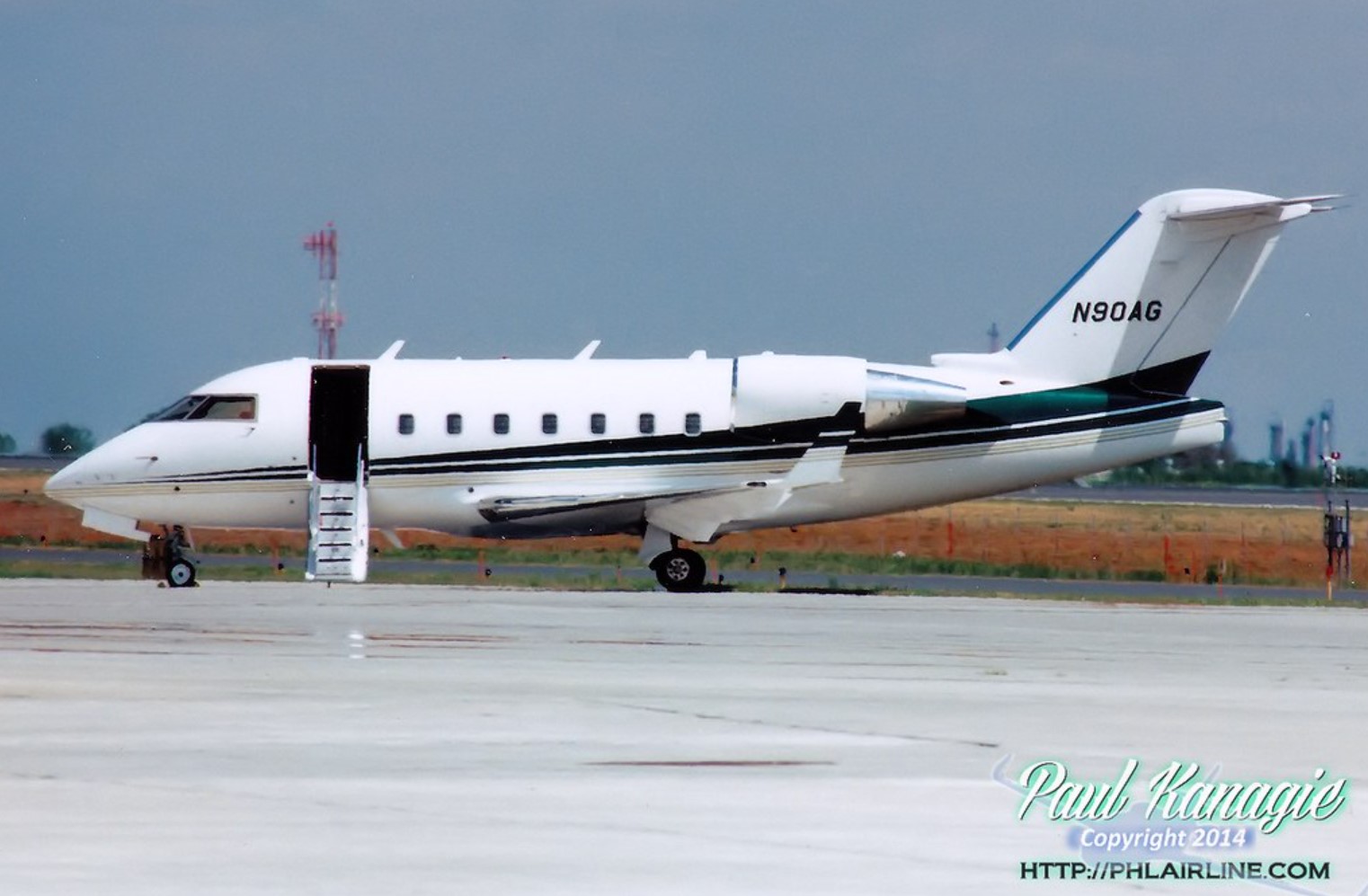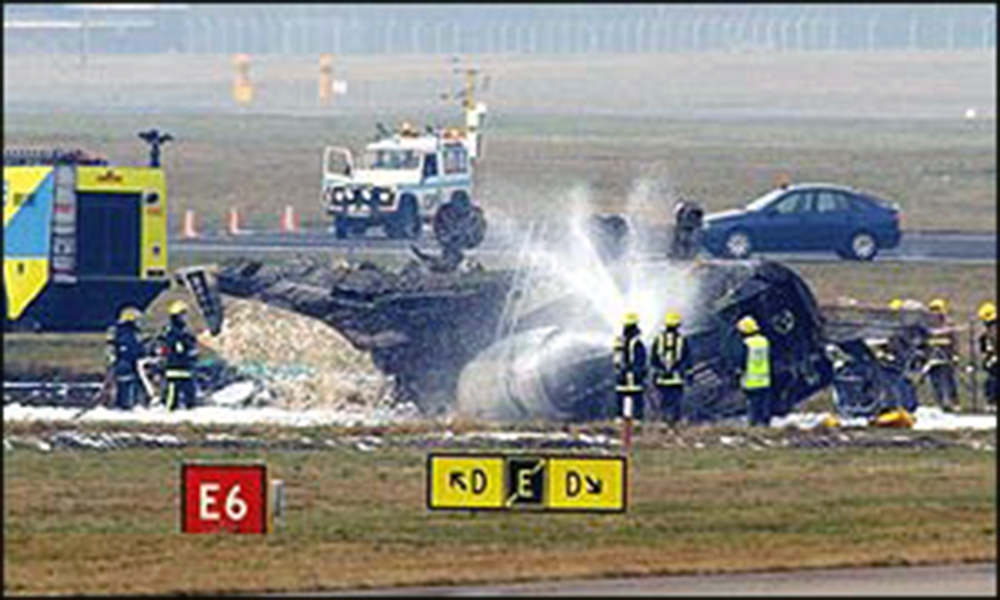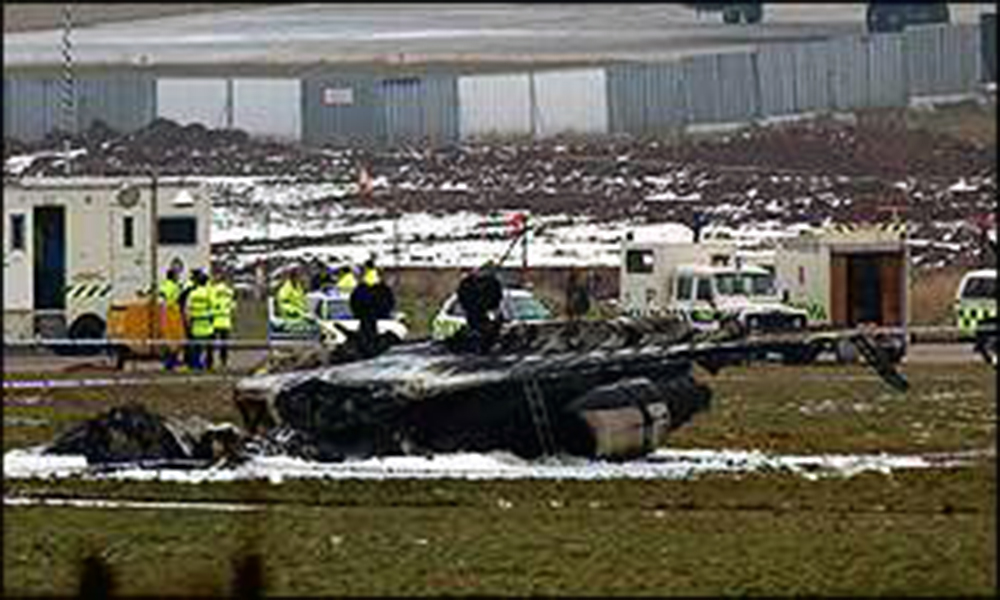Country
code
West Midlands
Crash of a Canadair CL-604 Challenger in Birmingham: 5 killed
Date & Time:
Jan 4, 2002 at 1207 LT
Registration:
N90AG
Survivors:
No
Schedule:
Birmingham - Bangor - Duluth
MSN:
5414
YOM:
1999
Crew on board:
2
Crew fatalities:
Pax on board:
3
Pax fatalities:
Other fatalities:
Total fatalities:
5
Captain / Total hours on type:
800.00
Copilot / Total hours on type:
800
Aircraft flight hours:
1594
Aircraft flight cycles:
797
Circumstances:
Following ATC clearance, engine start was at 1156 hrs and N90AG was cleared to taxi at 1201 hrs. All radio calls during the accident flight were made by the commander, seated in the right cockpit seat. During taxi, the crew completed their normal Before Takeoff Checks; these included confirmation that the control checks had been completed and that anti-ice might be required immediately after takeoff. Flap 20 had been selected for takeoff and the following speeds had been calculated and briefed by the pilots: V1 137 kt; VR 140 kt; V2 147 kt. By 1206 hrs, the aircraft was cleared to line up on Runway 15. At 1207 hrs, N90AG was cleared for takeoff with a surface wind of 140°/8 kt. The pilot in the left seat was handling the controls. Takeoff appeared normal up to lift-off. Rotation was started at about 146 kt with the elevator position being increased to 8°, in the aircraft nose up sense, resulting in an initial pitch rate of around 4°/second. Lift-off occurred 2 seconds later, at about 153 kt and with a pitch attitude of about 8° nose-up. Once airborne, the elevator position was reduced to 3° aircraft nose-up whilst the pitch rate increased to about 5°/second. Immediately after lift-off, the aircraft started to bank to the left. The rate of bank increased rapidly and 2 seconds after lift-off the bank angle had reached 50°. At that point, the aircraft heading had diverged about 10° to the left. Opposite aileron, followed closely by right rudder, was applied as the aircraft started banking; full right aileron and full right rudder had been applied within 1 second and were maintained until the end of the recording. As the bank angle continued to increase, progressively more aircraft nose-up elevator was applied. Stick-shaker operation initiated 3.5 seconds after lift-off and the recorders ceased 2 seconds later. The aircraft struck the ground, inverted, adjacent to the runway. The last recorded aircraft attitude was approximately 111° left bank and 13° nose-down pitch; the final recorded heading was about 114° (M). The aircraft was destroyed by impact forces and a post crash fire and all five occupants were killed, among them John Shumejda, President of the Massey-Ferguson Group and Ed Swingle, Vice President. The aircraft was leased by AGCO Massey-Ferguson.
Probable cause:
Causal factors:
1. The crew did not ensure that N90AG’s wings were clear of frost prior to takeoff.
2. Reduction of the wing stall angle of attack, due to the surface roughness associated with frost contamination, to below that at which the stall protection system was effective.
3. Possible impairment of crew performance by the combined effects of a non-prescription drug, jet-lag and fatigue.
1. The crew did not ensure that N90AG’s wings were clear of frost prior to takeoff.
2. Reduction of the wing stall angle of attack, due to the surface roughness associated with frost contamination, to below that at which the stall protection system was effective.
3. Possible impairment of crew performance by the combined effects of a non-prescription drug, jet-lag and fatigue.
Final Report:





Crash of a Boeing 737-200 in Coventry: 5 killed
Date & Time:
Dec 21, 1994 at 0953 LT
Registration:
7T-VEE
Survivors:
No
Schedule:
Algiers - Amsterdam - Coventry
MSN:
20758
YOM:
1973
Flight number:
AH702P
Crew on board:
3
Crew fatalities:
Pax on board:
2
Pax fatalities:
Other fatalities:
Total fatalities:
5
Captain / Total hours on type:
2187.00
Copilot / Total hours on type:
2055
Aircraft flight hours:
45633
Circumstances:
The Boeing 737, named "Oasis" was owned and operated by Air Algerie and had been leased by Phoenix Aviation in order to operate a series of live animal export flights from the UK to France and the Netherlands. On December 21, at 06:42 the plane departed from Amsterdam for a flight to Coventry. Weather at Coventry worsened and when arriving near Coventry, the RVR for runway 23 was 700 metres. The aircraft was not able to receive the Coventry runway 23 ILS as its dual navigation receiver system was not to an updated 40 channel ILS standard, so an SRA approach was flown. The radar guidance was completed at 0,5 miles from touchdown; the commander decided to discontinue the approach and execute a go-around. A holding pattern was then taken up at 07:44. When holding, the RVR further reduced to 600 m and the flight diverted to East Midlands to wait on the ground for weather improvement. The aircraft landed there at 08:08. At around 09:00 weather conditions improved to 1200 m visibility and an overcast cloud base at 600 feet. The flight departed East Midlands at 09:38 and climbed to FL40. Approaching Coventry, the crew received radar vectors for a runway 23 approach. After some initial confusion about the heading (the controller wanted the crew to turn left for 010°, while the crew understood 100°) the turn was continued to 260° and the SRA approach started at 12 miles from touchdown. The aircraft descended below the Minimum Descent Height (MDH) for the approach procedure and collided with an 86 feet high (291 feet ams) electricity transmission tower (pylon) which was situated on the extended centreline of the runway, some 1.1 miles from the threshold. The collision caused major damage to the inboard high lift devices on the left wing and the left engine. The consequent loss of lift on the left wing and the thrust asymmetry, caused the aircraft to roll uncontrollably to the left. When passing through a wings vertical attitude, the left wingtip impacted the gable end of a house. The aircraft continued rolling to an inverted attitude and impacted the ground in an area of woodland close to the edge of the housing conurbation. An intense fire ensued.
Probable cause:
The following factors were reported:
- The flight crew allowed the aircraft to descend significantly below the normal approach glide path during a Surveillance Radar Approach to runway 23 at Coventry Airport, in conditions of patchy lifting fog. The descent was continued below the promulgated Minimum Descent Height without the appropriate visual reference to the approach lighting or the runway threshold.
- The standard company operating procedure of cross-checking altimeter height indications during the approach was not observed and the appropriate Minimum Descent Height was not called by the non handling pilot.
- The performance of the flight crew was impaired by the effects of tiredness, having completed over 10 hours of flight duty through the night during five flight sectors which included a total of six approaches to land.
- The flight crew allowed the aircraft to descend significantly below the normal approach glide path during a Surveillance Radar Approach to runway 23 at Coventry Airport, in conditions of patchy lifting fog. The descent was continued below the promulgated Minimum Descent Height without the appropriate visual reference to the approach lighting or the runway threshold.
- The standard company operating procedure of cross-checking altimeter height indications during the approach was not observed and the appropriate Minimum Descent Height was not called by the non handling pilot.
- The performance of the flight crew was impaired by the effects of tiredness, having completed over 10 hours of flight duty through the night during five flight sectors which included a total of six approaches to land.
Final Report:





Crash of a Cessna 404 Titan in Birmingham
Date & Time:
Nov 27, 1985 at 1744 LT
Registration:
G-BKTJ
Survivors:
Yes
Schedule:
Birmingham – Norwich
MSN:
404-0236
YOM:
1978
Crew on board:
1
Crew fatalities:
Pax on board:
11
Pax fatalities:
Other fatalities:
Total fatalities:
0
Captain / Total hours on type:
242.00
Circumstances:
After a standard engine start the aircraft was taxied to runway 33 and, at 1743 hours, was cleared for takeoff and departure for Norwich. The pilot has stated that the initial takeoff acceleration appeared to be normal and that all engine power instruments were indicating in the green area. At an indicated airspeed of 100 knots he raised the nose and the aircraft lifted off the runway, however there was no further increase in airspeed. He retracted the landing gear and lowered the nose to attempt to gain more airspeed. At this time the airspeed had reduced to 90 knots and the pilot felt some vibration from the elevators. Realising that the aircraft would neither climb nor accelerate, the pilot selected what he hoped was a clear area in which to carry out a 'landing gear up' crash landing. All 12 occupants were injured, three of them seriously.
Final Report:


